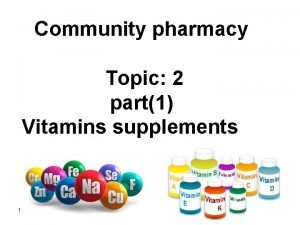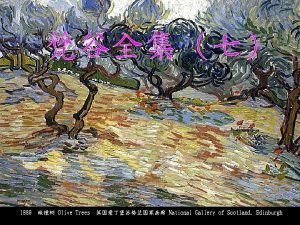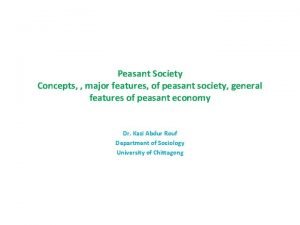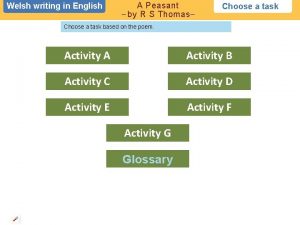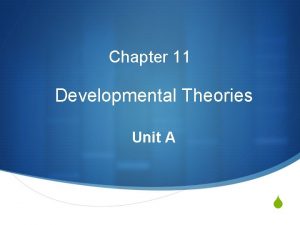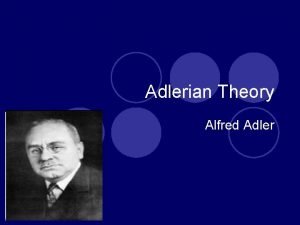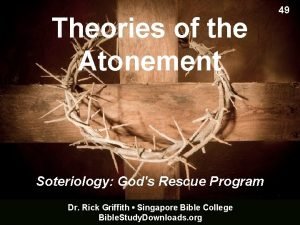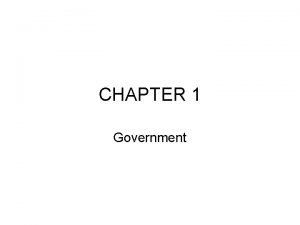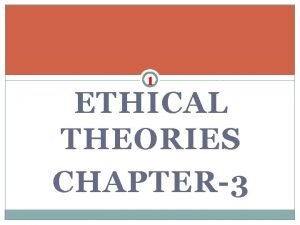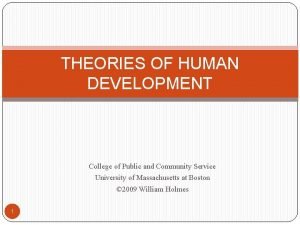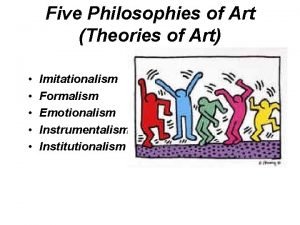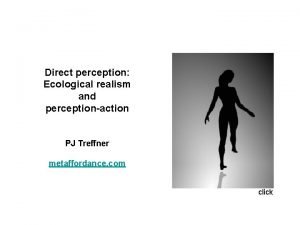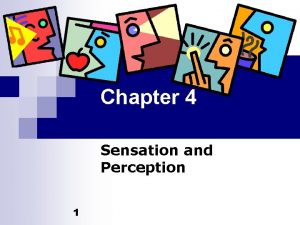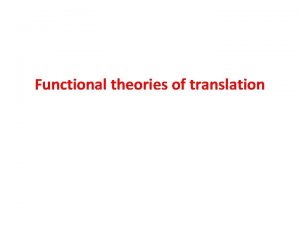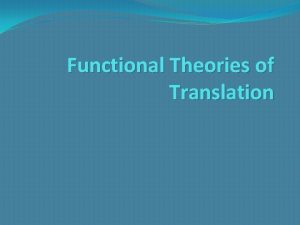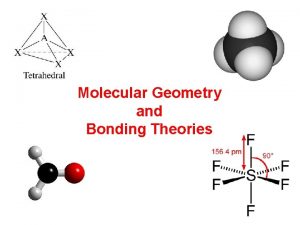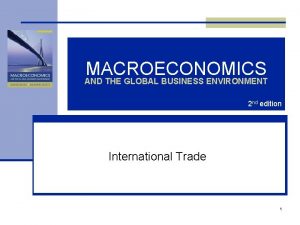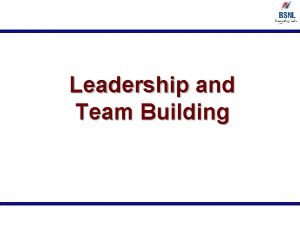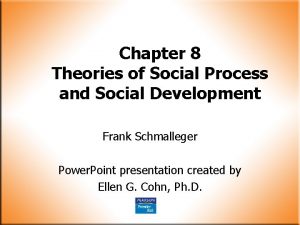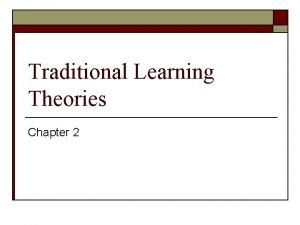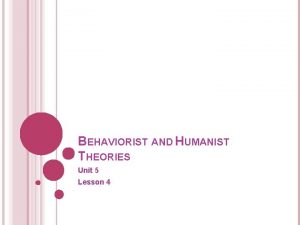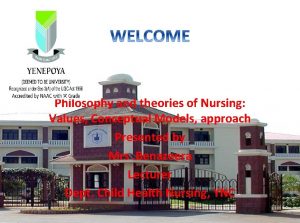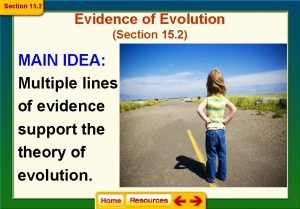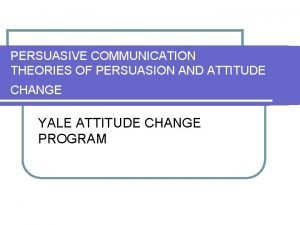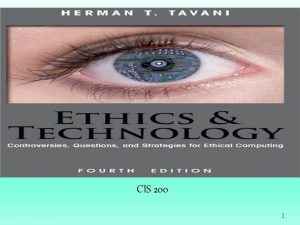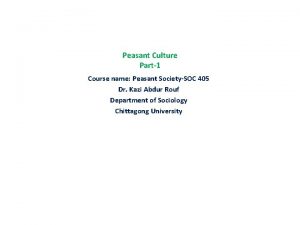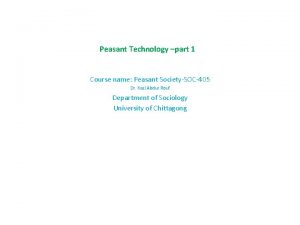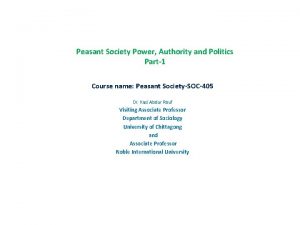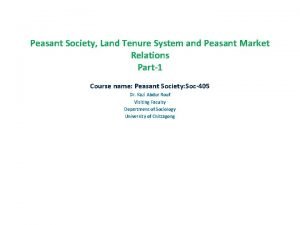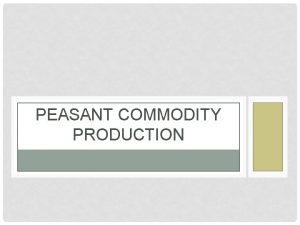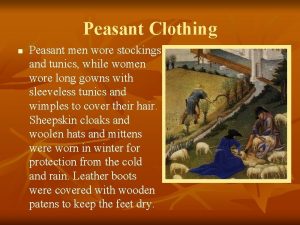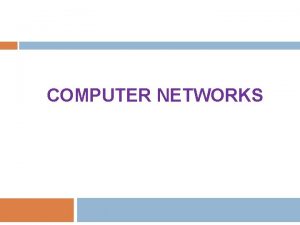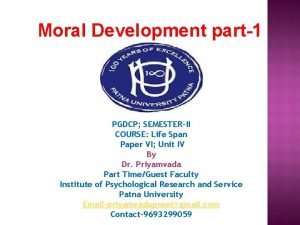Peasant Economy ad Peasant Economy Theories Part1 Course

















































- Slides: 49

Peasant Economy ad Peasant Economy Theories Part-1 Course name: Peasant Society-Soc 405, 2014 -2015 Dr. Kazi Abdur Rouf Department of Sociology University of Chittagong Room #401 Faculty of Social Sciences

Topics to be Covered • • • Traditional peasant economy and commercial peasant economy Family-based Nature of Production Unit Traditional peasant economy and commercial peasant economy (Shanin) Peasant family and peasant economy (Chyanov) Entrepreneurial peasant society Labor intensity and Chaynov’s declaration Capitalistic and feudal peasant economy Chynov Traditional economy in Bangladesh Specific Characteristic of the Peasant Economy Partially Market-oriented Nature of Peasant Output Indivisibility of the family income (Chynov)

Topics to be Covered continue-2 • • • • Nontransferable Nature of a portion of Family Labor Special Type of Risk Internalization Labor Intensive Technology Membership of a land group Commercial agriculture: Principal construct Articulation and break up of peasant agriculture Articulation in the market for products Articulation of Labor Market Break-up, Recovery and Persistence Conscious actions of the commercial sector from demographic and ecological factors Action by intermediate elements Classified functions of the intermediary elements by A. Warner Enterprises actions Consequence of demographics (Shanin) Consequences of Commercial Agriculture Classification of Societies in terms of means of Agricultural Production

Traditional peasant economy and commercial peasant economy • Traditional economy is voluntary economy that is risk for modern commercial sustainability. • Commercial peasant economy is profit oriented surplus agricultural production economy • It is in person agricultural production , but in commercial modern agriculture has absentee land lords • It has simple agricultural means of production , but commercial agriculture is about mechanized agriculture • Traditional agriculture treated backward agriculture having less agricultural production /productivity compare to modernized agriculture


Family-based Nature of Production Unit T. Shanin • Peasant family unit is the production unit and unit of consumption • Household economy is in separable from production activity. Here consumption is inseparable from production. • Single family, extended family is the integral part of production strategy for survival in the traditional peasant society. • Peasant units are as ‘consume-labor enterprise-labor force of the family as their means. • T. Shanan classical rural sociology-peasant unit characterized by a total integration of the peasant family’s life and its farming enterprises

Traditional peasant economy and commercial peasant economy • Shanin • Traditional agriculture depends on nurtures soil fertility and balance ecology • Modern agriculture uses chemical fertilizers and hybrid seeds that are risk for sustainable agriculture • Peasant family unit is the production unit and unit of consumption where household economy is in separable from production activity • Here consumption is inseparable from production • Single family, extended family is the integral part of production strategy for survival in the traditional peasant society

Peasant family and peasant economy • Classical rural sociology-peasant society (unit) is characterized by a total integration of the peasant family’s life and its farming enterprises (T. Shanan) • The family provides the work team for the farm. Agriculture enterprises (ferme) and the household economy (menge)

Peasant family and peasant economy • Chynov • Chyanov states that the family economic unit has not hired labor • However, the composition and size of the family is one of the main factors in organizing the peasant economic unit • Modern agriculture is about trade agriculture and commercialization of agriculture

Entrepreneurial peasant society • The entrepreneur can regulate the labor in his unit of production at will , but it dictates market • However, the head of the family in a peasant unit mainly uses his family members as labors of his agriculture production • S. H. Franklin highlights: The head of the peasant unit lacks the freedom of action (capitalist entrepreneurs) to regulate the labor force. • It is inhuman force available to find productive employment for all of its members • It is challenging to find alternative job opportunities • However, the main task in traditional peasant society is to maximize the labor input rather than profit or other indicators of efficiency.

Labor intensity and Chaynov’s declaration • If the amount of land available increases, the number of working days per hector will tend to fall • In the peasant economy, the dominant forces of substitution is between land labor • In contrast, commercial agriculture has dominant capitalist feature • Here (commercial agriculture) the substitution (exchange) is occur between capital and labor and between capital and land • Here resources are land , labor forces , other means of production and so on • Production technology (production know-how) and mechanisms are the features of commercial agriculture, but the peasant economy peasant is self-exploitation of labor force (Chyanov). • However, peasant is unable to retain distinct agricultural economy through agricultural production in Bangladesh

Capitalistic and feudal peasant economy Chynov continue -2 • The capitalistic and feudal peasant economy becomes remnant/rapidly disappear because of rapid growth of commercial agricultural and manufacturing • The commercial agriculture encourages modernization • Neo-classical economist, do not consider peasant family unit distinct from agricultural enterprises, but the difference observed based on scales of production and availability of other factors • What, how ad how much to produce were considered and governed by the ratio between the marginal productivity and price factors • Economic analysis mentioned that subsistence production of peasant is fall down

The capitalistic and feudal peasant economy Chaynov continue-3 • Moreover, its social analysis reexamined in terms of traditional agriculture has less agriculture productivity • Here two dichotomy-traditional and modern; feudalism and capitalism • Traditional agricultural economy lack of organizing production (A. V. Chaynov) • Criticisms are dualism create a view-peripheral section split into two section: the traditional, semi-feudal or feudal sector and pre-capitalist regarded as historical object of a colonial past; and • Modern, dynamic or capitalist sector-whose task is to absorb and consume products. • Modern agriculture creates consumerism in the society

Traditional economy • Traditional economy, peripheral economy-neglects universal rationality, maximize of the neoclassical type • Two types of peasant economy Chynov): • Peasant agricultural economics and • Commercial of capitalist agriculture • In Bangladesh context, insertion (inclusion)/articulation of peasant economy need o be considered within the major main economy-peasant agricultural economy • Agricultural farming and agricultural processing industries can generate rural employment in the villages • Peasant agricultural economy could reduce rural- urban migration • Rural peasant economy could reduce rural unemployment, balance ecology of the villages • Rural peasant economy could develop sustainable agricultural /green development in Bangladesh

Specific Characteristic of the Peasant Economy • The concept of the peasant economy encompasses domestic agricultural activity where family type agriculture (units) engaged in the process of production • This is in the cycle of reproduction of peasant living and working- peasants are reproduction of agricultural producers • Its main character is the subsistence of production for all family members of peasant-replacement of the means of production used in production cycle and to deal with family illness • What, how and how much to produce and what to do with the product obtained is to move to substantial agriculture or commercial agriculture

Specific Characteristic of the Peasant Economy continue-2 • However there are contradictions among theorists how much to produce to for maximizing rates of profits and accumulations. • Traditional and commercial agriculture also classified by scale of production • ‘Factor cost’- market price of inputs, land rent, wages of family wages, value of input purchased from market. • Neo-classical term-purchase of land-pay more than the value expected rentthat discounted internal rate of return on capital that encourage an entrepreneur to invest.

Partially Market-oriented Nature of Peasant Output • Peasant economy ceases to be a ‘natural economy’ • It is about a simple ‘mercantile economy’. The market economy is on-thespot consumption economy : peasant economy is about self-sufficient economy • The partially market-oriented economy is about final consumption of goods, must be acquired from the market, using money • USA farmers are commercial nature; however, the family unit generally comes to market in its capacity as a producer • The decision what to produce is based on the marketability of the product.

Partially market-oriented nature of peasant output continue-2 • Selling products what has produced is part of peasant economy • Market identify how much will be sent to market. • Partially market-oriented peasant economy depends on ecology nature or socio-economic nature of the peasants • Now peasant production depends on purchased inputs and goods for agricultural reproduction decision made by the market.

Indivisibility of the family income (Chynov) • Chynov • In traditional peasant family, total family income (gross or net; in cash and in kinds derived from the joint efforts of its numbers of the family unit. • As a result it is not possible to separate the product from wages or profits (Chaynov).

Comments/Questions Next class Peasant more economic theories

Peasant Economy ad Peasant Economy Theories part-2 Course name: Peasant Society-Soc 405, 2014 -2015 Dr. Kazi Abdur Rouf Department of Sociology University of Chittagong Room #401 Faculty of Social Sciences

Nontransferable Nature of a portion of Family Labor • One special feature of the peasant society is that it makes use of labor force which would not create value in other production sector • The children, old people, women and the head of the family and his adult children- all are working unsystematically • This is one reason for the family unit bring product to the market at lower prices than communal and commercial productions and prices • Marginal labor force is using in the traditional agriculture, but they are not regarded labor force in commercial sector

Special Type of Risk Internalization • Risk internalization is to co-opt with entrepreneurial behavior of profit and accumulation of resources • Entrepreneurs have risk or uncertainty in their profits. Hence these uncertainty views as probability functions • They calculate this risk of proportionality between profit and risk • Peasants view it “ survival algorithim” (Lipton) which lead them to avoid risks despite the potential profits • They internalize this risk and uncertainty through they generate lower incomes. Here they do not cultivate certain high yielding crops to avoid complex marketing mechanism.

Labor Intensive Technology • In local market peasant tendency is to reduce the purchase • As a result, the intensity of means f production per worker or purchase inputs of products are generally well below those of commercial capitalist agriculture • Decision regarding what to produce is guided minimizing purchase or hired inputs and means of production.

Membership of a land group • Apearse, Tepieht and A. Warman • Peasant society becomes a part of a larger society and shares a common territorial base • Apearse defines “land group “ a group of families forming part of a larger society • Tepieht calls it is the “protective shell of the family economy”. They depend on no-market exchange • A Warman says, “ Family unit cannot remain to produce without capital and without accumulation and cannot subsist without reserves or savings in the dominant capitalist society and without support of a larger groupings. ” • Hence peasant needs to form an agrarian community for their preserving rights and peasant economy.

Commercial agriculture: Principal construct • In commercial society, there is a separation between capital and labor power • Profit, wages and even land rent are categories between owners of means of production, land owners and sellers of labor power. • Kinship production is exclusively not market oriented, little left to allow for local internal consumption (Shanin) • Production is unrelated to market what the producers produce • Rather they produce what their families consume • Risk and uncertainty arise strictly in terms of probabilities • Producers internalize in the decision-making processes as ratios between profit expected and probability associated with each level/scale/ amount/ magnitude. • The principal aim of production is to secure at least average profitentrepreneurial phenomenon.

Articulation and break up of peasant agriculture • There is a positive effect/position of the peasant economy in the national society/economy • However the question is how two societies characterize in influencing the peasant economy in the national society • The concept of articulation: Relationships (system of relationships) with the rest of the economy, forming an integral whole economy • Articulation takes the form of exchange of goods and services (or values) between sectors: capitalist agriculture and urban industrial complex • Market relations among markets are for products, inputs, labor and even land.

Articulation in the market for products • An initial form of articulation in the market for products to the peasant is come to sell part of his outputs and to buy inputs and goods for his reproduction • However, trade-prices of what he buys and what he sells, are always been systematically unfavorable to him- “Primordial”-undervaluation of peasant products (between peasant production and capitalist production) • Reproduction of the economy is crucially dependent on relationship between food prices; wage levels, the rate of profit, but in this process there exit inequality in exchange of food prices and wages of labors • Hence there needs a mechanism-raise and fall of market depending on the greater or lesser bargaining power (social power in the market).

Articulation in the Market for Products continue-2 • The small peasant landowner behaves neither like the owner of property nor like the capitalist entrepreneurs • He contents himself with the equivalent of a wage, without raising the question of rest or even the question of profit • The small peasant behaves exactly like a wage paid price worker • Commercial farmers invest in farms for their agricultural production in a larger scale • They are not like family agriculture-not self exploitation of family labor • Here states subsidies directly through the medium of low prices for puts and products and credit at low interest rates and • Through the financing of infrastructure for the beneficiaries that are not charged.

Articulation of Labor Market • Labors engaged by the commercial sector at wages lower than their cost of survival or reproduction • The commercial agricultural economy accumulates resources by exploiting labor low wages • The average rate of profit prevailed in agriculture and industry would lead to higher agricultural prices on wages, profits and accumulation • The labor force employed in commercial agriculture originates from peasant economy, permits a reduction of the wage bill by wages paid per day worked lower than in other section • Moreover, payment paid only for days actually worked • Rural and migration from areas of peasant agriculture to areas of commercial agriculture confirmed this interdependence.

Articulation of Labor Market: continue-2 • However, labor power in less wages can be increased and achieveddepends on exclusively on the bargaining power between the parties • Wage labor and employers of production and reproduction of the peasant economy(Chynov) • There are two articulation mechanisms- (1) product market and (2) labor market have common basis (Chaynov). • Here both undermine the peasant production capacity and undervalue its working time • This capacity is the source both of the peasant’s strength in the sense of working and its weakness in the sense of a force working for its breakup (Shanin).

Comments/Questions Next class Peasant more economic theories

Peasant Economy ad Peasant Economy Theories part-3 Course name: Peasant Society-Soc 405, 2014 -2015 Dr. Kazi Abdur Rouf Department of Sociology University of Chittagong Room #401 Faculty of Social Sciences

Break-up, Recovery and Persistence Chynov • Liberalism schools of thoughts are liberals-proper rationalists, positivists, Marxists, and so on) • They assume the transitional nature of the peasantry- bourgeois, • Rest converted into proletarians-as a result of the vigor of capitalist development • Peasantry societies were considered cultural and social relies from former times • In developing countries, the peasantry remains one of the largest groups and they are in transitory has been very lengthy. • To prevent disappearance of the peasantry, it is important to create peasant forms of organizations of production where they do not exist.

Break-up, Recovery and Persistence continue-2 • Break-up of the peasant mean the process which permit the family unit to survive using its own resources • Peasants loss their abilities to generate volume of outputs and means of production • Recovery means the processes which reverse the above mentioned trend and lead to the creation of peasant units in areas where they did not exist before.

Conscious actions of the commercial sector from demographic and ecological factors • • Action by the State (Chynov and Shanin) State policies involve subsidies to the peasant sector, such as credit at preferential rates, support prices, minimum wages and so on These are actions tend to limit or check the break-up of the peasant unit by trade, would be achieved in free market conditions Agrarian reform and new settlement theory and policies impede the breakup of peasant units These programs encourage the creation of subdivision of larger geographical units and the development of legislation and action to protect the units created.

Action by intermediate elements • Moreover, public investment in irrigation, or improving communications and prospects for the export of produce, has frequently led to increased imposition commercial agriculture • However, these processes have increased peasants vulnerability • Action makes by intermediate elements means various types of mechanism for intermediation • Link the peasantry to the rest of the economy and permit the extraction of surpluses at the level of distribution and exchange (Shanin) • These intermediary persons and or institutions make possibilities opened up new peasant economy (Shanin) • However, these are derived from lesser bargaining power between peasants and the intermediaries monopoly of the channels.

Classified functions of the intermediary elements by A. Warner • Material adaption of products- scaling down the peasant product and scaling up that leaves the peasant sector for the rest of the economy • Conversion of symbols, involving “translation” into the peasant language of the external norms of trade and accounting • The physical movement of the products- enter or leave the peasant economy from and to the external world • The mobilization of finance by fully integrated in the market is for consumer goods or inputs • It is possible if he sold his products or labor power himself • These functions make it possible to extend market relations in the process of reproduction of the peasant economy and • To integrate it in the rest of the national and international economy.

Enterprises actions • Enterprises actions are responsible for processing and intermediation • This is the contracts make between large agro-industrial or agri-business enterprises and the peasants of specific regions • These contracts have tendency to abandon direct control of land the processes of primary production and • Replace them by financial and commercial control network of small and medium-sized “independent Producers” • This happened by creating peasantry economically attached to them’, but business agriculture would not accept to them

Enterprises actions contiue-2 • This criterion can be used to distinguish at least three important categories within the peasant agriculture sector • The infra-subsistence segment, or “poor peasant’ segment, made incomes from outside minimum subsistence income • This segment appears fastest growth in Bangladesh • The stationary, “simple reproduction” or “average peasant” segment, made up of the peasantry whose product is sufficient to cover the fund for family consumption • The surplus-producing or “rich” peasant segment are those who have their resources, more or less systematically generate a surplus over and above.

Consequence of demographics Shanin • There is deterioration in the land/man ratio- decline in the productive potential of the existing land • This is a force which contributes the break-up of the peasantry and fragmentation of land • It is the result of the sub-division of plots as a consequence of population growth

Consequences of Commercial Agriculture • The commercial agricultural process rises in the fragility or vulnerability of the peasant economy • Within the peasant segmentation, polarization- minority of the units not only served in the preventing break-up • However, it turns the intensification in market-oriented relations and create accumulation • Majority of peasants or members of the family go outside of the plot to obtain incomes • In this process, there developed the heterogeneity differentiation among them and stratify the peasant segment. • Here the important distinction is production unit and the land group • This criterion can be used to distinguish at least three important categories with the peasant agriculture sector.

Classification of Societies in terms of means of Agricultural Production • Wolf classified societies onto three categories: (A) Primitive Society (B) Peasant Society © Industrialized Unban Society • Society becomes polarized from primitive society to industrialized unban society • Primitive society is a hunting and food gathering society, but later urban life developed by division of labor • In primitive society, people have limited social and economic activities • Primitive society is totally isolated from other tribes or distance society they live. They have nomadic life move in group.

Classification of Societies in terms of means of Agricultural Production continue-2 • Surplus production absent in peasant society and primitive society, there was no production incentive • Peasant produce crops for his family need and preserve seeds for next year agriculture • Crop production for market is secondary for the peasant, but commercial agriculture main target is trade and commerce; sale in the market • There is no business or profit motive like commercial agriculture exist in the primitive society and peasant society

Classification of Societies in terms of means Agricultural Production – continue-3 • Peasant society has subsistence agriculture, but in commercial agriculture, farmers produce surplus production for profit • Peasants often ignore food security and food for market • Peasant society is different from primitive society and urban society • Peasant society uses animal power, manual power for agricultural production and utilize natural resources • In primitive society, there is no land owning system- lord and landless, big farmer, middle farmer and less people rather all have equal access to land within their own community.


Classification of Societies in terms of means Agricultural Production – continue-4 • Eric Wolf • According to Eric Wolf peasant involved in surplus production for carrying their expenses of ceremonial fund where all need to contribute to annual/other fests and ceremonies • Peasant produce extra crops for paying his land tax • Moreover, land rental system developed as land ownership is unequal in land tenure society. Peasant has to pay tax for cultivating land. • Agricultural tax could be either in cash, or crops or in labor • Land owners, tenants, and share croppers etc division of classes created in the land tenure society


Questions/comments
 Vitamin part1
Vitamin part1 Athens vs sparta differences
Athens vs sparta differences Peasant meal 1642
Peasant meal 1642 Ts revolution ch 1
Ts revolution ch 1 Peasant woman binding sheaves
Peasant woman binding sheaves Characteristics of peasant society
Characteristics of peasant society Peasant jobs
Peasant jobs Who is iago prytherch in the poem a peasant
Who is iago prytherch in the poem a peasant Be like a russian peasant in a french patisserie
Be like a russian peasant in a french patisserie Tudor peasant clothes
Tudor peasant clothes Building with bricks
Building with bricks Course title and course number
Course title and course number Course interne course externe
Course interne course externe Theories of personality
Theories of personality Chapter 11 developmental theories
Chapter 11 developmental theories Adler theories
Adler theories Nursing theories related to teenage pregnancy
Nursing theories related to teenage pregnancy Jcnot4me
Jcnot4me Traits of capitalism
Traits of capitalism Ethical theories explained
Ethical theories explained Theories of human development
Theories of human development Theories of art
Theories of art Bottom up top down psychology
Bottom up top down psychology Theories of personality quiz
Theories of personality quiz Modern biological theories of crime
Modern biological theories of crime 11 theories of counseling
11 theories of counseling Perception gestalt principles
Perception gestalt principles Theories of international marketing
Theories of international marketing Psychoanalytic theory
Psychoanalytic theory Functional theories of translation
Functional theories of translation Theories of human rights
Theories of human rights Reiss text types
Reiss text types Shell theories for electrostatic force
Shell theories for electrostatic force Normative theories of mass communication
Normative theories of mass communication Theories of communication in health and social care
Theories of communication in health and social care Equity theory of motivation
Equity theory of motivation Molecular geometry and bonding theories
Molecular geometry and bonding theories New trade theory
New trade theory Theories of leadership
Theories of leadership Social process theories criminology
Social process theories criminology Traditional learning theories
Traditional learning theories Behaviorist vs humanist
Behaviorist vs humanist 8 normative theory of communication
8 normative theory of communication Leadership exam questions
Leadership exam questions Study of meaning in language
Study of meaning in language Nursing conceptual models
Nursing conceptual models Section 15-2 review evidence of evolution
Section 15-2 review evidence of evolution What theories
What theories What is the yale attitude change approach
What is the yale attitude change approach What are the 4 ethical theories
What are the 4 ethical theories
